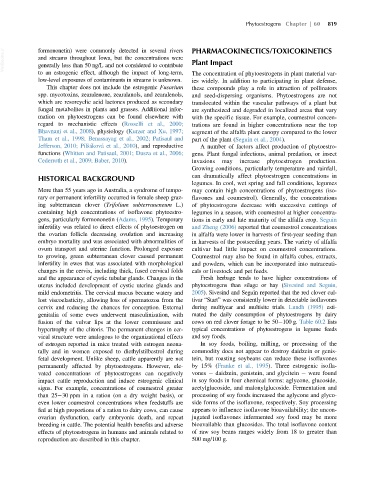Page 861 - Veterinary Toxicology, Basic and Clinical Principles, 3rd Edition
P. 861
Phytoestrogens Chapter | 60 819
VetBooks.ir formononetin) were commonly detected in several rivers PHARMACOKINECTICS/TOXICOKINETICS
and streams throughout Iowa, but the concentrations were
Plant Impact
generally less than 50 ng/L and not considered to contribute
to an estrogenic effect, although the impact of long-term, The concentration of phytoestrogens in plant material var-
low-level exposures of contaminants in streams is unknown. ies widely. In addition to participating in plant defense,
This chapter does not include the estrogenic Fusarium these compounds play a role in attraction of pollinators
spp. mycotoxins, zearalenone, zearalanols, and zearalenols, and seed-dispersing organisms. Phytoestrogens are not
which are resorcyclic acid lactones produced as secondary translocated within the vascular pathways of a plant but
fungal metabolites in plants and grasses. Additional infor- are synthesized and degraded in localized areas that vary
mation on phytoestrogens can be found elsewhere with with the specific tissue. For example, coumestrol concen-
regard to mechanistic effects (Rosselli et al., 2000; trations are found in higher concentrations near the top
Bhavnani et al., 2008), physiology (Kurzer and Xu, 1997; segment of the alfalfa plant canopy compared to the lower
Tham et al., 1998; Benassayag et al., 2002; Patisaul and part of the plant (Seguin et al., 2004).
Jefferson, 2010; Pilˇ sa ´kova ´ et al., 2010), and reproductive A number of factors affect production of phytoestro-
functions (Whitten and Patisaul, 2001; Dusza et al., 2006; gens. Plant fungal infections, animal predation, or insect
Cederroth et al., 2009; Baber, 2010). invasions may increase phytoestrogen production.
Growing conditions, particularly temperature and rainfall,
HISTORICAL BACKGROUND can dramatically affect phytoestrogen concentrations in
legumes. In cool, wet spring and fall conditions, legumes
More than 55 years ago in Australia, a syndrome of tempo- may contain high concentrations of phytoestrogens (iso-
rary or permanent infertility occurred in female sheep graz- flavones and coumestrol). Generally, the concentrations
ing subterranean clover (Trifolium subterraneneum L.) of phytoestrogens decrease with successive cuttings of
containing high concentrations of isoflavone phytoestro- legumes in a season, with coumestrol at higher concentra-
gens, particularly formononetin (Adams, 1995). Temporary tions in early and late maturity of the alfalfa crop. Seguin
infertility was related to direct effects of phytoestrogen on and Zheng (2006) reported that coumestrol concentrations
the ovarian follicle decreasing ovulation and increasing in alfalfa were lower in harvests of first-year seeding than
embryo mortality and was associated with abnormalities of in harvests of the postseeding years. The variety of alfalfa
ovum transport and uterine function. Prolonged exposure cultivar had little impact on coumestrol concentrations.
to growing, green subterranean clover caused permanent Coumestrol may also be found in alfalfa cubes, extracts,
infertility in ewes that was associated with morphological and powders, which can be incorporated into nutraceuti-
changes in the cervix, including thick, fused cervical folds cals or livestock and pet feeds.
and the appearance of cystic tubular glands. Changes in the Fresh herbage tends to have higher concentrations of
uterus included development of cystic uterine glands and phytoestrogens than silage or hay (Sivesind and Seguin,
mild endometritis. The cervical mucus became watery and 2005). Sivesind and Seguin reported that the red clover cul-
lost viscoelasticity, allowing loss of spermatozoa from the tivar “Start” was consistently lower in detectable isoflavones
cervix and reducing the chances for conception. External during multiyear and multisite trials. Lundh (1995) esti-
genitalia of some ewes underwent masculinization, with mated the daily consumption of phytoestrogens by dairy
fusion of the vulvar lips at the lower commissure and cows on red clover forage to be 50 100 g. Table 60.2 lists
hypertrophy of the clitoris. The permanent changes in cer- typical concentrations of phytoestrogens in legume feeds
vical structure were analogous to the organizational effects and soy foods.
of estrogen reported in mice treated with estrogen neona- In soy foods, boiling, milling, or processing of the
tally and in women exposed to diethylstilbestrol during commodity does not appear to destroy daidzein or genis-
fetal development. Unlike sheep, cattle apparently are not tein, but roasting soybeans can reduce these isoflavones
permanently affected by phytoestrogens. However, ele- by 15% (Franke et al., 1995). Three estrogenic isofla-
vated concentrations of phytoestrogens can negatively vones daidzein, genistein, and glycitein were found
impact cattle reproduction and induce estrogenic clinical in soy foods in four chemical forms: aglycone, glucoside,
signs. For example, concentrations of coumestrol greater acetylglucoside, and malonylglucoside. Fermentation and
than 25 30 ppm in a ration (on a dry weight basis), or processing of soy foods increased the aglycone and glyco-
even lower coumestrol concentrations when feedstuffs are side forms of the isoflavone, respectively. Soy processing
fed at high proportions of a ration to dairy cows, can cause appears to influence isoflavone bioavailability; the uncon-
ovarian dysfunction, early embryonic death, and repeat jugated isoflavones infermented soy food may be more
breeding in cattle. The potential health benefits and adverse bioavailable than glucosides. The total isoflavone content
effects of phytoestrogens in humans and animals related to of raw soy beans ranges widely from 18 to greater than
reproduction are described in this chapter. 500 mg/100 g.

